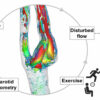The discovery of the quantum Hall effects in the 1980s revealed the existence of novel states of matter called “Laughlin states,” in honor of the American Nobel prize winner who successfully characterized them theoretically. These exotic states specifically emerge in 2D materials, at very low temperature and in the presence of an extremely strong magnetic field.
In a Laughlin state, electrons form a peculiar liquid, where each electron dances around its congeners while avoiding them as much as possible. Exciting such a quantum liquid generates collective states that physicists associate with fictitious particles, whose properties drastically differ from electrons: these “anyons” carry a fractional charge (a fraction of the elementary charge) and they surprisingly defy the standard classification of particles in terms of bosons or fermions.
For many years, physicists have explored the possibility of realizing Laughlin states in other types of systems than those offered by solid-state materials, in view of further analyzing their peculiar properties. However, the required ingredients (the 2D nature of the system, the intense magnetic field, the strong correlations among the particles) has proved extremely challenging.
Writing in Nature, an international team gathered around the experimental group of Markus Greiner in Harvard report on the first realization of a Laughlin state using ultracold neutral atoms manipulated by lasers. The experiment consists in trapping a few atoms in an optical box, and in implementing the ingredients required for the creation of this exotic state: a strong synthetic magnetic field and strong repulsive interactions among the atoms.
In their article, the authors reveal characteristic properties of the Laughlin state by imaging the atoms one by one through a powerful quantum-gas microscope. They demonstrate the peculiar “dance” of the particles, which orbit around each other, as well as the fractional nature of the realized atomic Laughlin state.
This milestone opens the door to a wide new field of exploration of Laughlin states and their cousins (e.g. the so-called Moore-Read state) in quantum simulators. The possibility of creating, imaging and manipulating anyons under a quantum-gas microscope is particularly appealing, in view of exploiting their unique properties in the lab.
More information:
Julian Léonard, Realization of a fractional quantum Hall state with ultracold atoms, Nature (2023). DOI: 10.1038/s41586-023-06122-4. www.nature.com/articles/s41586-023-06122-4
Provided by
Université libre de Bruxelles
Citation:
Study reports first realization of a Laughlin state in ultracold atoms (2023, June 21)



